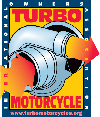
|
Home About Us Bikes Rallies Tech Help Merchandise Classifieds Newsletters Turbo People Photos Forum Links |
|
|
|
Tech Help Home Honda General Tech Help Yamaha General Tech Help Suzuki General Tech Help Kawasaki General Tech Help |
|
|
|
Tech
Help |
|
ACG (Stator) Connector Meltdown
There are two other areas in the charging system which often succumb to heat damage, leaving you stranded. Fortunately, there are simple steps you can take to completely prevent these failures. Both problem areas are electrical connectors, and both are located under the left side cover. The first is the ACG connector. This is a three-pronged connector. One half of the connector attaches to three yellow wires which disappear into the top rear of the engine case. These wires attach internally to the stator. The other half of the connector also has three yellow wires attached, but these are much shorter and go to the voltage regulator. Separate the two halves of the white connector and examine the wires, lugs, and especially the white plastic separating the three copper lugs. You want to see virgin, unmelted plastic. The yellow wire leading to each copper lug should be yellow clear to the lug, with no signs of charring as it nears the lug. Be concerned, but do not be surprised if the plastic has suffered meltdown, and the yellow wires turn brown or black as they come into the connector. Should two of the wires touch inside the connector while you are riding, I hope you ate your Wheaties that morning because you will be pushing your Turbo home that afternoon! Not to fear however, as to identify this problem before it causes damage is the best one can hope for. There are two solutions.
This meltdown is such a common occurrence that Honda has put together a handy ACG Connector Repair Kit (Honda P/N 31105-ML8-305) which sells for about ten bucks. The kit includes both male and female connectors with six inches of wire fixed in each lug, six pieces of shrink tubing, an insufficient amount of solder, and straight-forward instructions. All one does is splice it in.
There is one important touch I always perform when installing this kit. Even if you examined your ACG connector and all appeared well, you still want to do this to your existing connector. Each individual copper lug is locked into the connector by a small pin. Each lug can be removed from the connectors by inserting a small sharp object into each pin access hole from the front of the connector, releasing the latch while pulling on the wire from the back side. When finished, you will have six yellow wires crimped to six copper lugs. One cause of the ACG connector meltdowns is this crimp connection. In any friction connection, (i.e., non-soldered) there is resistance between the two joined pieces, in this case the lug and the wire. When current flows through a resistance, heat is created, thus your melted connector. Our goal is to reduce this resistance. This is accomplished by flowing a small amount of solder into each lug only where it is crimped to the wire. Once this simple procedure is performed, you now have negligible resistance at this point. Thus your days of melted ACG connectors are over, provided you follow the button-up procedure as follows. When finished flowing a little solder into each crimp joint, snap the lugs back into their connectors. It does not matter which of the three yellow wires goes to which location in the connector. Pack each of the three female lugs with dielectric compound (also available from Honda) before joining the two halves of the connector. You are now virtually assured of a trouble-free future for this connector.
The second solution to the ACG connector meltdown problem, more drastic but undoubtedly the most effective, is to do away with the connector completely by splicing the three yellow wires together directly with solder and shrink wrap. This will make your next stator swap a little more difficult by virtue of not having the quick disconnect. Before you consider the hardwire option, consider also that I have used the Honda ACG repair kit with very good results, never having experienced a meltdown after an installation as described above. However, if you continue to have meltdowns after trying the ACG repair kit, the hardwire solution will certainly be the answer for you.
© Turbo Motorcycle International Owners Association